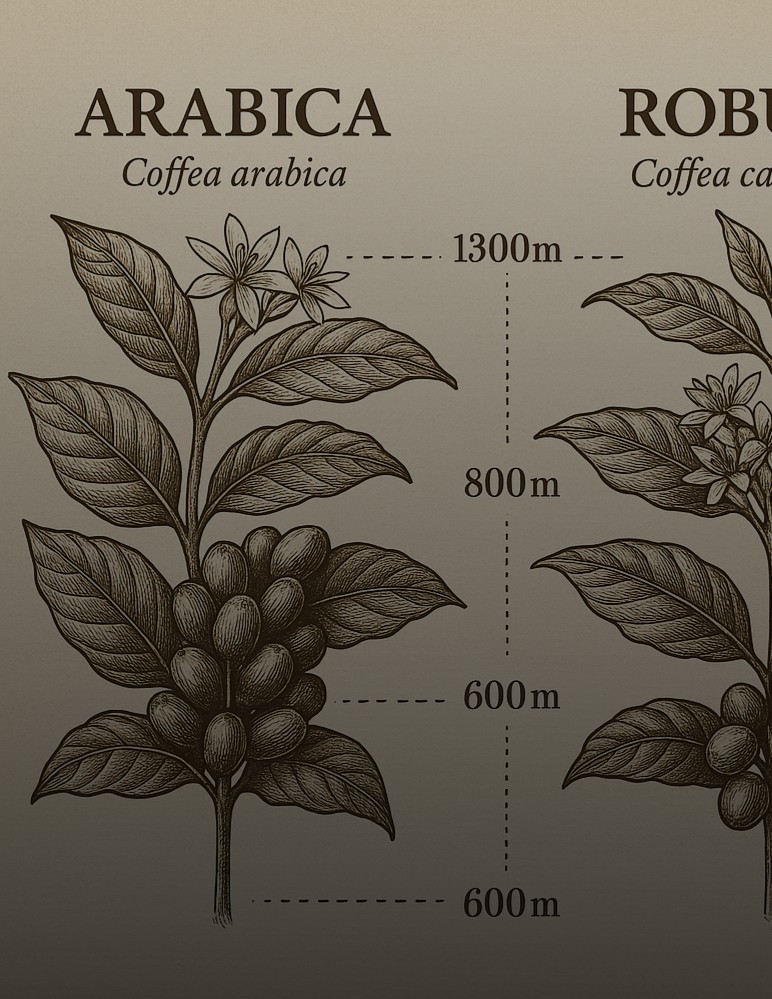
“A great coffee doesn’t tell you where it’s from. It shows you – in every cup.”
Why Origin and Altitude Shape the Taste of Your Espresso

BY DAVID MARTELLA
June 4, 2025
When we think of Italian espresso, we think of dark crema, a full body, and a taste that lingers. But what’s really behind this experience? Beyond the craft of roasting, another crucial factor often goes unnoticed: the origin and altitude of the coffee beans.
At Caffè Martella, these aren’t just geographic labels. They’re deliberate choices – key ingredients in crafting a unique and balanced blend. Instead of relying on single origins, we build our Maximum Class using carefully selected Arabica and Robusta beans from diverse regions and elevations – for a flavor profile that stands out.
Origin and Terroir – What Do They Mean in Coffee?
Just like wine, coffee is shaped by its terroir – a combination of climate, soil, altitude, and farming methods. Beans grown at higher altitudes mature more slowly, developing complex notes like floral, fruity, or nutty aromas. Beans grown lower down tend to produce more body and bitterness – perfect for espresso.
This is why the right combination of different origins and elevations is essential for crafting a coffee with real character.
Arabica and Robusta – Two Worlds, One Purpose
Our blend includes both Arabica and Robusta beans – but not just any beans. Each origin was selected to bring specific sensory qualities:
Arabica coffees in Maximum Class:
Alta Mogiana Franca (950–1100 m, Brazil)
→ Sweet, mild acidity, nutty notes
Cerrado Mineiro (800–1250 m, Brazil)
→ Chocolatey, balanced, rounded
Supremo 18 Sierra Madre (1300–1700 m, Colombia)
→ Fruity, elegant, complex
Barahona AA Screen 18 (800 m, Dominican Republic)
→ Full aroma, spicy depth
Robusta coffees in Maximum Class:
Kasai Provence GG Selected (600 m, Congo)
→ Bold, earthy, full-bodied
Uganda Screen 18 (1000–1500 m)
→ Light chocolatey, balanced bitterness
Parchment Kaapi Royal (900–1100 m, India)
→ Clean Robusta, low acidity, silky texture
Cherry AAA Screen 19 (900–1100 m, India)
→ Spicy, nutty, creamy body
The Secret Is in the Blend – No Single Origin, No Guesswork
At Caffè Martella, we deliberately don’t follow the single-origin trend. Why?
Because coffee isn’t a solo act – not if you want a consistently perfect result in the cup. Origin, elevation, and variety each bring something different: fruitiness, body, sweetness, intensity, crema. Only through a precisely tuned blend of these components can we create the espresso we envision – balanced, elegant, and powerful.
Maximum Class is the result of this philosophy. It combines high-altitude Arabicas with selected Robustas from mid-elevations. The beans' slow maturation in high altitudes creates complex aromas – while the Robustas contribute body, crema, and long-lasting flavor.
Why Altitude Really Matters
Take this example:
Our Sierra Madre Arabicas grow at up to 1700 meters. Their slow ripening creates an elegant acidity and refined fruity notes – without overpowering the cup. These beans are denser and harder, requiring skilled roasting that only an experienced roaster can deliver.
By contrast, Kasai Robusta grown at 600 m brings fullness, bitterness, and depth. In the blend, it adds the body espresso lovers crave – but without the harshness of low-grade Robusta.
The Martella Taste: Craft, Selection, Balance
Our goal isn’t to list the most countries on the label. Our goal is to make every cup of Maximum Class taste like Martella:
- With depth and structure
- With floral highlights and a sweet finish
- With rich crema and lasting flavor
That’s why we’ve chosen eight unique origins – each with a distinctive altitude profile.
Conclusion: Taste Begins at the Source – Perfection in the Roast
What do origin and altitude have to do with your espresso? Everything. But it’s only through the craft of roasting and expert blending that these elements become a true symphony.
At Caffè Martella, we believe:
“A great coffee doesn’t tell you where it’s from. It shows you – in every cup.”
Want to taste the difference?
Try our Maximum Class and discover what origin really means.